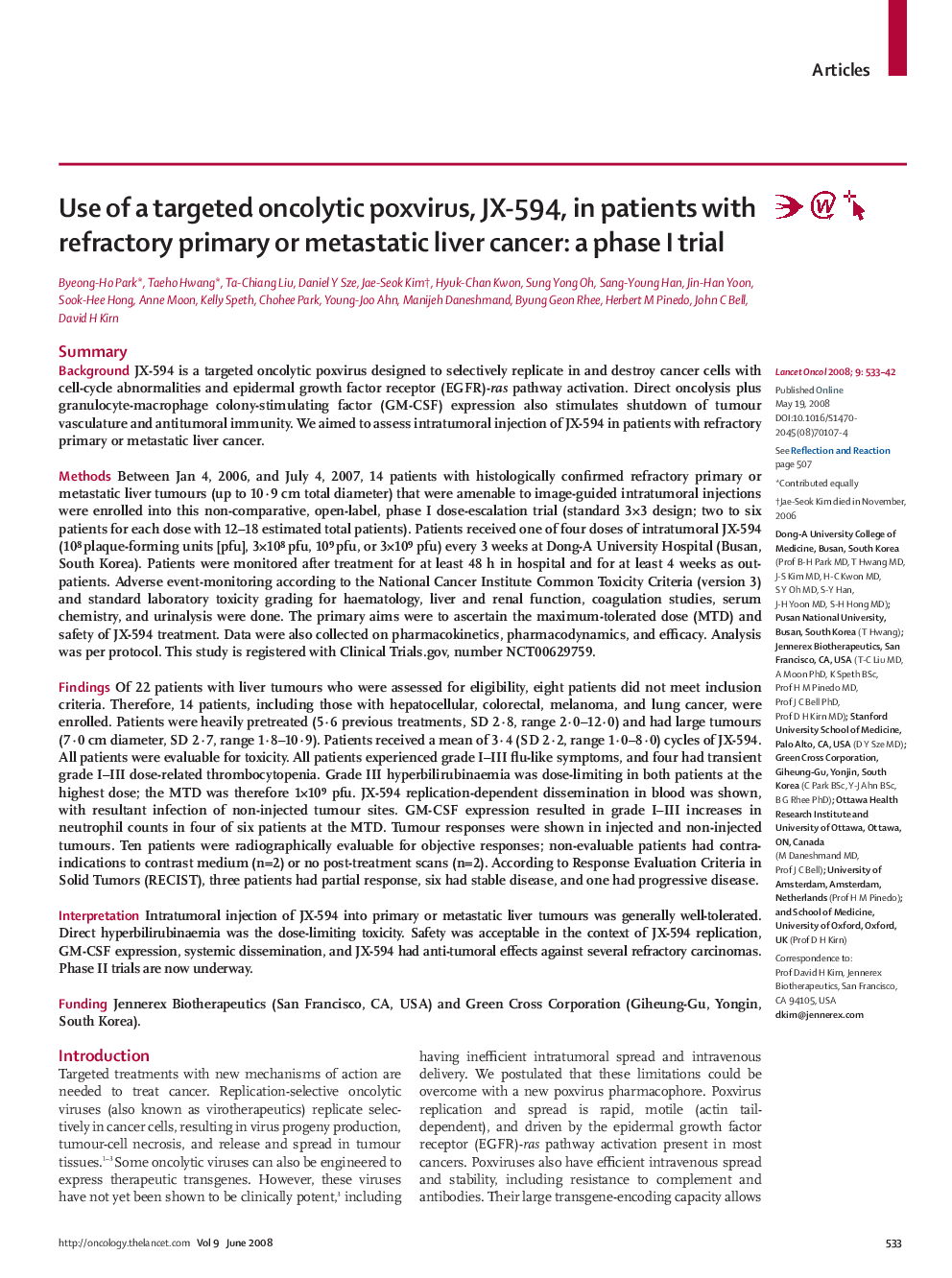| کد مقاله | کد نشریه | سال انتشار | مقاله انگلیسی | نسخه تمام متن |
|---|---|---|---|---|
| 3994842 | 1258917 | 2008 | 10 صفحه PDF | دانلود رایگان |

SummaryBackgroundJX-594 is a targeted oncolytic poxvirus designed to selectively replicate in and destroy cancer cells with cell-cycle abnormalities and epidermal growth factor receptor (EGFR)-ras pathway activation. Direct oncolysis plus granulocyte-macrophage colony-stimulating factor (GM-CSF) expression also stimulates shutdown of tumour vasculature and antitumoral immunity. We aimed to assess intratumoral injection of JX-594 in patients with refractory primary or metastatic liver cancer.MethodsBetween Jan 4, 2006, and July 4, 2007, 14 patients with histologically confirmed refractory primary or metastatic liver tumours (up to 10·9 cm total diameter) that were amenable to image-guided intratumoral injections were enrolled into this non-comparative, open-label, phase I dose-escalation trial (standard 3×3 design; two to six patients for each dose with 12–18 estimated total patients). Patients received one of four doses of intratumoral JX-594 (108 plaque-forming units [pfu], 3×108 pfu, 109 pfu, or 3×109 pfu) every 3 weeks at Dong-A University Hospital (Busan, South Korea). Patients were monitored after treatment for at least 48 h in hospital and for at least 4 weeks as out-patients. Adverse event-monitoring according to the National Cancer Institute Common Toxicity Criteria (version 3) and standard laboratory toxicity grading for haematology, liver and renal function, coagulation studies, serum chemistry, and urinalysis were done. The primary aims were to ascertain the maximum-tolerated dose (MTD) and safety of JX-594 treatment. Data were also collected on pharmacokinetics, pharmacodynamics, and efficacy. Analysis was per protocol. This study is registered with ClinicalTrials.gov, number NCT00629759.FindingsOf 22 patients with liver tumours who were assessed for eligibility, eight patients did not meet inclusion criteria. Therefore, 14 patients, including those with hepatocellular, colorectal, melanoma, and lung cancer, were enrolled. Patients were heavily pretreated (5·6 previous treatments, SD 2·8, range 2·0–12·0) and had large tumours (7·0 cm diameter, SD 2·7, range 1·8–10·9). Patients received a mean of 3·4 (SD 2·2, range 1·0–8·0) cycles of JX-594. All patients were evaluable for toxicity. All patients experienced grade I–III flu-like symptoms, and four had transient grade I–III dose-related thrombocytopenia. Grade III hyperbilirubinaemia was dose-limiting in both patients at the highest dose; the MTD was therefore 1×109 pfu. JX-594 replication-dependent dissemination in blood was shown, with resultant infection of non-injected tumour sites. GM-CSF expression resulted in grade I–III increases in neutrophil counts in four of six patients at the MTD. Tumour responses were shown in injected and non-injected tumours. Ten patients were radiographically evaluable for objective responses; non-evaluable patients had contraindications to contrast medium (n=2) or no post-treatment scans (n=2). According to Response Evaluation Criteria in Solid Tumors (RECIST), three patients had partial response, six had stable disease, and one had progressive disease.InterpretationIntratumoral injection of JX-594 into primary or metastatic liver tumours was generally well-tolerated. Direct hyperbilirubinaemia was the dose-limiting toxicity. Safety was acceptable in the context of JX-594 replication, GM-CSF expression, systemic dissemination, and JX-594 had anti-tumoral effects against several refractory carcinomas. Phase II trials are now underway.FundingJennerex Biotherapeutics (San Francisco, CA, USA) and Green Cross Corporation (Giheung-Gu, Yongin, South Korea).
Journal: - Volume 9, Issue 6, June 2008, Pages 533–542